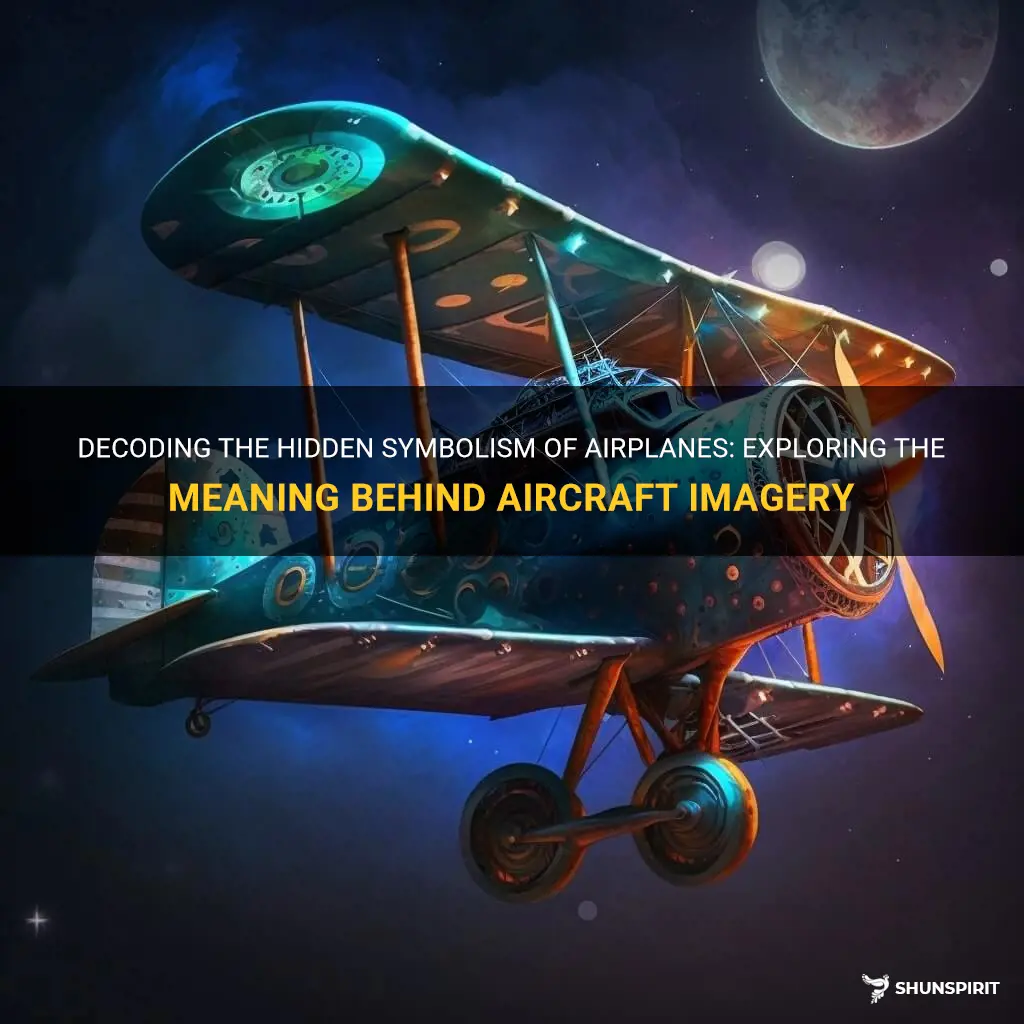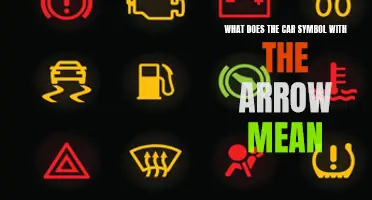
Airplanes have become powerful symbols of human ambition, progress, and the desire for freedom. These graceful and mighty machines soaring high in the sky have captured our imagination and represent our relentless pursuit of new horizons. Whether it is Leonardo da Vinci's dream of flying or the marvel of modern aviation, airplanes symbolize both the triumph of human ingenuity and our eternal quest to overcome limitations. From their ability to traverse great distances to the symbolism of taking flight, airplanes are a profound metaphor for the human spirit and our yearning for exploration and adventure.
What You'll Learn
- What is the historical significance and symbolism of airplanes in different cultures?
- How has the symbolism of airplanes evolved over time and in different contexts?
- What are some common interpretations of airplane symbolism in dreams and literature?
- How does airplane symbolism relate to notions of travel, freedom, and adventure?
- Are there any cultural variations in the meaning and symbolism of airplanes?

What is the historical significance and symbolism of airplanes in different cultures?
Throughout history, airplanes have played a significant role in various cultures and symbolized different aspects of human achievement, progress, and freedom. From cultural myths and legends to technological advancements, the symbolism and historical significance of airplanes are diverse and fascinating.
In many ancient cultures, the concept of flying or soaring through the skies was associated with gods and divine powers. For example, in Greek mythology, the god Hermes was often depicted with winged sandals or a winged helmet, allowing him to fly swiftly between the mortal world and Mount Olympus. In Aztec culture, the deity Quetzalcoatl was depicted as a feathered serpent, symbolizing wisdom and the ability of flight.
As human civilization developed and the idea of flight became a reality, airplanes took on a new level of symbolism. In the early 20th century, the Wright Brothers' successful flight in 1903 marked a turning point in human history. Airplanes became a symbol of human ingenuity, innovation, and the determination to conquer the skies. They represented progress and the potential for limitless exploration and discovery.
During World War I and World War II, airplanes played a crucial role in military operations. They became symbols of power and dominance in warfare. The development of air warfare strategies and the introduction of bombers and fighter planes brought a new dimension of warfare, changing the course of battles and the fate of nations. The symbolism of airplanes during this time was closely tied to victory, heroism, and national pride.
In the post-war era, commercial aviation emerged, revolutionizing travel and connecting people across the globe. Airplanes became symbols of freedom, adventure, and the ability to transcend borders and distances. They represented the dream of exploration and the capacity to experience different cultures and lands.
In many cultures, airplanes also became symbols of luxury and prestige. Flying on an airplane was seen as a status symbol, reserved for the wealthy and privileged. This perception changed over time as air travel became more accessible and affordable to the general public, but the symbolic association with progress and modernity remained.
Today, airplanes continue to hold a significant place in our collective consciousness. They symbolize the advancements in technology and engineering, representing human achievement and the ability to push boundaries. They remain a vital part of global travel and commerce, connecting people and goods across continents. Airplanes also symbolize the importance of diplomacy and international cooperation, as air travel enables people from different cultures and countries to interact and exchange ideas.
In conclusion, airplanes have had a profound historical significance and symbolism in different cultures. From their association with gods and divine powers in ancient mythologies to their representation of progress, freedom, and exploration in modern times, airplanes have captured the imagination of humanity. They symbolize human ingenuity, advancements in technology, and the ability to transcend physical barriers. As we continue to push the boundaries of flight, airplanes will undoubtedly continue to hold a special place in our collective consciousness, representing both our dreams and our achievements.
The Importance of Fire Fighting Symbols and Their Meanings
You may want to see also

How has the symbolism of airplanes evolved over time and in different contexts?
Airplanes have always held a certain fascination for humanity. From the early days of flight to the present, these machines have symbolized progress, freedom, and the limitless possibilities of human achievement. However, the symbolism associated with airplanes has evolved over time and has taken on different meanings in different contexts.
In the early 20th century, airplanes were a symbol of scientific and technological advancement. The Wright brothers' first flight in 1903 marked a significant milestone in human history and sparked a wave of excitement and wonder. As aviation technology progressed, airplanes became a symbol of human ingenuity and the triumph of science over the constraints of nature.
During the World Wars, airplanes took on a new symbolism as tools of war. Bombers and fighter planes represented power and military might. Air supremacy became a critical objective in warfare, and countries developed advanced aircraft to gain an edge over their adversaries. Airplanes became symbols of national pride and strength, representing the ability to project force across great distances.
In the post-war era, airplanes began to symbolize a new kind of freedom. With the advent of commercial aviation, air travel became accessible to the masses. Airplanes represented the ability to travel quickly and effortlessly across great distances, opening up new possibilities for business, tourism, and cultural exchange. The jet age brought about a sense of excitement and adventure, with airplanes embodying the spirit of exploration and the breaking of boundaries.
In recent years, airplanes have taken on new symbolic meanings in the face of environmental concerns and globalization. With the growing awareness of the impact of air travel on climate change, airplanes have come to represent the carbon footprint of modern society. They have become symbols of excess and the environmental consequences of our industrialized world.
At the same time, airplanes continue to symbolize the interconnectedness of the globalized world. They enable people to travel and connect with others from different cultures and backgrounds. Airplanes represent the shrinking of distances and the breaking down of barriers, allowing people to understand and appreciate different perspectives.
In popular culture, airplanes have also taken on various symbolic meanings. They have been featured in films and literature as vehicles of escape, symbolizing freedom from societal constraints and the pursuit of dreams. Airplanes have played a significant role in adventure stories, representing the thrill of discovery and the exhilaration of exploring new frontiers.
Overall, the symbolism of airplanes has evolved over time and in different contexts. From symbols of scientific progress to tools of war, from symbols of freedom and adventure to icons of environmental impact and globalization, airplanes continue to hold a powerful place in our collective imagination. They remind us of the human desire to push the boundaries of what is possible and to explore new horizons.
Unlocking the Symbolic Meaning of the Nest: What Does It Represent?
You may want to see also

What are some common interpretations of airplane symbolism in dreams and literature?
Airplanes have long been a source of fascination in both dreams and literature. These flying machines often symbolize a sense of freedom, adventure, and exploration. However, the interpretation of airplane symbolism can vary depending on the context and the specific elements of the dream or literary work. In this article, we will explore some common interpretations of airplane symbolism in dreams and literature.
In dreams, airplanes often represent a desire for freedom and escape. Flying in an airplane can evoke a sense of liberation from the constraints of everyday life. It can symbolize a need for independence or a longing to break free from the limitations that hold us back. For example, dreaming of being on a plane that is about to take off but feeling anxious or hesitant may indicate a fear of taking risks or venturing into the unknown.
Another common interpretation of airplane symbolism in dreams is related to the idea of journey or transition. Airplanes, with their ability to travel long distances in a relatively short time, can symbolize embarking on a new phase or chapter in life. This interpretation is often associated with personal growth, self-discovery, or a major life change. It may reflect a sense of anticipation, excitement, or apprehension for what lies ahead.
Airplanes can also signify a desire for a broader perspective or a need to gain distance from a situation. Looking down at the world from a bird's-eye view offers a unique and expansive viewpoint. In dreams or literature, airplanes can represent a need to see things from a different angle, to gain a better understanding of the bigger picture. This interpretation may suggest a need to step back and assess a situation objectively or seek new perspectives on a problem.
In addition to dreams, airplane symbolism is also prevalent in literature. In many works of fiction, airplanes are used as a metaphor for freedom, adventure, or escape. They can represent a yearning for a life beyond the constraints of society or a sense of wanderlust. For example, in J.R.R. Tolkien's "The Hobbit," the eagles symbolize the freedom and escape from the perils of the journey.
Airplanes in literature can also serve as a symbol of technological progress or modernity. They may represent the rapid pace of change or the advancements of civilization. This interpretation is often evident in science fiction or dystopian novels, where airplanes symbolize the power and control of a futuristic society.
Finally, airplanes in literature can also represent themes of courage, risk, and heroism. Characters who fly or pilot airplanes often embody bravery, as they face the dangers and challenges associated with aviation. Whether it is the courageous pilot in Antoine de Saint-Exupéry's "The Little Prince" or the daring aviators in Tom Wolfe's "The Right Stuff," airplanes can symbolize the courage to defy limitations and push boundaries.
In conclusion, the symbolism of airplanes in dreams and literature can encompass a wide range of interpretations. They can symbolize freedom, adventure, and escape, as well as personal growth, perspective, and the desire for a broader view. In literature, airplanes can also serve as metaphors for technological progress or heroism. The specific context and elements of the dream or literary work will ultimately determine the exact meaning of airplane symbolism.
Understanding the Symbol of Education: Its Meaning and Importance
You may want to see also

How does airplane symbolism relate to notions of travel, freedom, and adventure?
Airplanes have become powerful symbols in our society, representing not just a means of transportation, but also ideas of travel, freedom, and adventure. The image of a plane soaring through the sky is often associated with the desire to explore new places, break free from mundane routines, and embark on exciting journeys.
Travel is a fundamental aspect of human existence, enabling us to experience different cultures, landscapes, and perspectives. Airplanes have revolutionized the way we travel, making it possible to reach far-off destinations in a matter of hours. The symbolism of an airplane embodies the notion of travel in its purest form, representing the ability to traverse great distances and discover the unknown. It evokes a sense of excitement and anticipation, as well as the promise of new experiences and opportunities.
The freedom associated with airplanes stems from their ability to take us wherever we want to go, transcending geographical barriers. It represents the freedom to explore and expand our horizons, breaking free from the limitations of our daily lives. When we board a plane, we leave behind the constraints of our physical surroundings and set off on an adventure, unrestricted by borders or boundaries. The airplane symbolizes the freedom to roam the world, to seek out new adventures and create our own paths.
Moreover, airplanes embody the spirit of adventure. They appeal to our innate desire for exploration and discovery. The act of flying itself is exhilarating, allowing us to witness breathtaking aerial views and offering a unique perspective on the world below. The journey by airplane becomes an adventure in itself, with each takeoff and landing signaling a new chapter in our lives. It represents the thrill of stepping into the unknown, embracing the unexpected, and taking risks.
The airplane's symbolism is not limited to the physical act of travel. It also resonates with our aspirations and dreams. It represents the desire to break free from our comfort zones, to challenge ourselves, and to embark on new experiences. The airplane symbolizes the pursuit of a life less ordinary, one filled with excitement, novelty, and personal growth. It serves as a reminder to never settle for mediocrity, but to constantly seek out new adventures and broaden our horizons.
In conclusion, the airplane symbolism is deeply intertwined with notions of travel, freedom, and adventure. It represents the desire to explore the world, break free from limitations, and embark on new experiences. Whether it is the physical act of flying or the metaphorical journey of personal growth, airplanes evoke a sense of excitement and possibility. They serve as a reminder of the limitless possibilities that await us when we embrace the spirit of travel, freedom, and adventure.
What Does the Moon Symbol Mean on Discord: Exploring its Significance
You may want to see also

Are there any cultural variations in the meaning and symbolism of airplanes?
Airplanes have become an integral part of modern life, serving as a major mode of transportation and connecting people across the globe. While the fundamental purpose of airplanes remains the same across different cultures, there are variations in the meaning and symbolism associated with them. These cultural variations can shed light on how different societies perceive and relate to this revolutionary invention.
In Western cultures, airplanes are often seen as a symbol of progress, advancement, and freedom. They represent mankind's ability to conquer the skies and overcome physical limitations. The airplane is revered for its speed, efficiency, and the ability to reach far-off destinations in a relatively short amount of time. In these cultures, airplanes are synonymous with travel, adventure, and the desire for exploration. They embody the spirit of adventure and the human quest for new experiences.
In contrast, some indigenous cultures view airplanes in a more spiritual or mystical light. These cultures may see airplanes as messengers or carriers of spirits. They believe that airplanes have the power to transcend the earthly realm and connect the physical world with the spiritual realm. For them, airplanes represent a bridge between different realms of existence and symbolize the divine or supernatural. In these cultures, airplanes can be seen as sacred or holy objects that hold spiritual significance.
In certain Eastern cultures, airplanes are associated with prosperity and economic development. They are seen as symbols of a nation's progress and technological advancement. Air travel is often perceived as a hallmark of a modern, developed society. Additionally, airplanes are regarded as tools of commerce and trade, facilitating the movement of goods and people across borders. In these cultures, airplanes represent not only progress but also the ability to connect and engage with the global community.
Furthermore, the symbolism of airplanes can also vary based on historical and political contexts. For example, during times of war or conflict, airplanes may be associated with destruction, fear, and loss. They can become symbols of violence or oppression, particularly when used for military purposes. On the other hand, during peaceful times, airplanes may symbolize unity, cooperation, and international diplomacy. They can also represent hope and resilience in the face of adversity.
In conclusion, the meaning and symbolism of airplanes can vary across different cultures. While they are generally seen as symbols of progress and innovation, the specific connotations can differ based on cultural, spiritual, economic, and historical factors. Understanding these variations allows for a deeper appreciation of the diverse perspectives and interpretations surrounding this modern marvel.
Decoding the Symbolic Language of Tower Fans: Unraveling the Meaning Behind the Enigmatic Icons
You may want to see also
Frequently asked questions
Answer: The airplane symbol is often associated with travel, freedom, and adventure. It represents the ability to soar above limitations and experience new places and opportunities. It can also symbolize progress, as airplanes are a modern invention that has revolutionized transportation.
Question: What does it mean to dream about an airplane?
Answer: Dreaming about an airplane can have various meanings depending on the context of the dream. Generally, it represents ambitions, goals, and desires that are taking off or coming into focus. It can symbolize the need for adventure or a desire to escape from a current situation. It may also suggest a need for speed and a desire to achieve goals quickly.
Question: What is the spiritual meaning of an airplane?
Answer: In spiritual terms, the airplane symbol represents a higher perspective and the ability to rise above earthly concerns. It can represent spiritual ascension, the journey of the soul, and the connection between the physical and spiritual realms. It may also symbolize divine guidance and protection, as airplanes require skilled pilots and careful navigation to reach their destinations safely.







